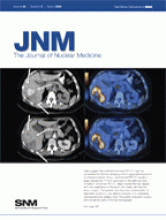About the Cover
Cover image

Data suggest that contrast-enhanced PET/CT might be considered the first-line restaging tool for suspected recurrence of colorectal cancer. At top, unenhanced PET/CT reveals a large, hypodense 18F-FDG-avid lesion in the right liver lobe. At bottom, enhanced PET/CT clearly reveals the liver vessels and their relationship to the lesion and clearly identifies the lesion margins. This patient, who had been treated earlier for sigmoidal carcinoma, was referred because of an increasing carcinoembryonic antigen level. The patient underwent surgery, and the lesions were confirmed histologically.
See page 354.



